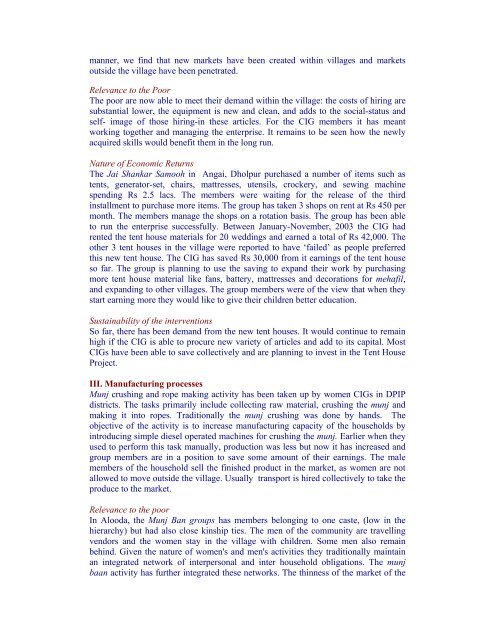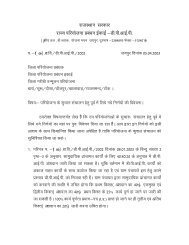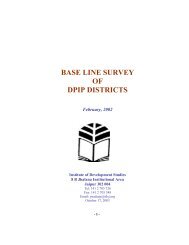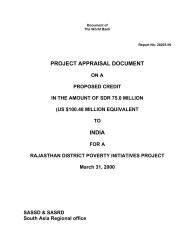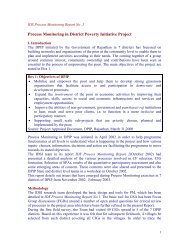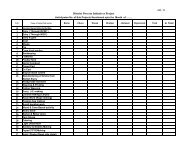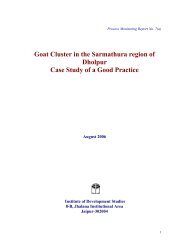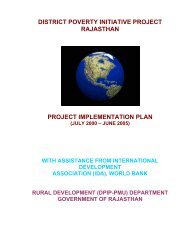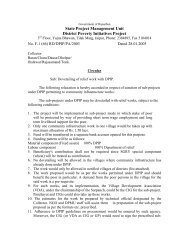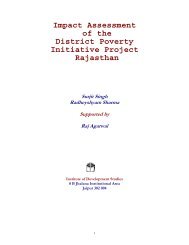Sub Project Activities in DPIP How Near, How Far from Good Practices
Sub Project Activities in DPIP How Near, How Far from Good Practices
Sub Project Activities in DPIP How Near, How Far from Good Practices
You also want an ePaper? Increase the reach of your titles
YUMPU automatically turns print PDFs into web optimized ePapers that Google loves.
manner, we f<strong>in</strong>d that new markets have been created with<strong>in</strong> villages and markets<br />
outside the village have been penetrated.<br />
Relevance to the Poor<br />
The poor are now able to meet their demand with<strong>in</strong> the village: the costs of hir<strong>in</strong>g are<br />
substantial lower, the equipment is new and clean, and adds to the social-status and<br />
self- image of those hir<strong>in</strong>g-<strong>in</strong> these articles. For the CIG members it has meant<br />
work<strong>in</strong>g together and manag<strong>in</strong>g the enterprise. It rema<strong>in</strong>s to be seen how the newly<br />
acquired skills would benefit them <strong>in</strong> the long run.<br />
Nature of Economic Returns<br />
The Jai Shankar Samooh <strong>in</strong> Angai, Dholpur purchased a number of items such as<br />
tents, generator-set, chairs, mattresses, utensils, crockery, and sew<strong>in</strong>g mach<strong>in</strong>e<br />
spend<strong>in</strong>g Rs 2.5 lacs. The members were wait<strong>in</strong>g for the release of the third<br />
<strong>in</strong>stallment to purchase more items. The group has taken 3 shops on rent at Rs 450 per<br />
month. The members manage the shops on a rotation basis. The group has been able<br />
to run the enterprise successfully. Between January-November, 2003 the CIG had<br />
rented the tent house materials for 20 wedd<strong>in</strong>gs and earned a total of Rs 42,000. The<br />
other 3 tent houses <strong>in</strong> the village were reported to have ‘failed’ as people preferred<br />
this new tent house. The CIG has saved Rs 30,000 <strong>from</strong> it earn<strong>in</strong>gs of the tent house<br />
so far. The group is plann<strong>in</strong>g to use the sav<strong>in</strong>g to expand their work by purchas<strong>in</strong>g<br />
more tent house material like fans, battery, mattresses and decorations for mehafil,<br />
and expand<strong>in</strong>g to other villages. The group members were of the view that when they<br />
start earn<strong>in</strong>g more they would like to give their children better education.<br />
Susta<strong>in</strong>ability of the <strong>in</strong>terventions<br />
So far, there has been demand <strong>from</strong> the new tent houses. It would cont<strong>in</strong>ue to rema<strong>in</strong><br />
high if the CIG is able to procure new variety of articles and add to its capital. Most<br />
CIGs have been able to save collectively and are plann<strong>in</strong>g to <strong>in</strong>vest <strong>in</strong> the Tent House<br />
<strong>Project</strong>.<br />
III. Manufactur<strong>in</strong>g processes<br />
Munj crush<strong>in</strong>g and rope mak<strong>in</strong>g activity has been taken up by women CIGs <strong>in</strong> <strong>DPIP</strong><br />
districts. The tasks primarily <strong>in</strong>clude collect<strong>in</strong>g raw material, crush<strong>in</strong>g the munj and<br />
mak<strong>in</strong>g it <strong>in</strong>to ropes. Traditionally the munj crush<strong>in</strong>g was done by hands. The<br />
objective of the activity is to <strong>in</strong>crease manufactur<strong>in</strong>g capacity of the households by<br />
<strong>in</strong>troduc<strong>in</strong>g simple diesel operated mach<strong>in</strong>es for crush<strong>in</strong>g the munj. Earlier when they<br />
used to perform this task manually, production was less but now it has <strong>in</strong>creased and<br />
group members are <strong>in</strong> a position to save some amount of their earn<strong>in</strong>gs. The male<br />
members of the household sell the f<strong>in</strong>ished product <strong>in</strong> the market, as women are not<br />
allowed to move outside the village. Usually transport is hired collectively to take the<br />
produce to the market.<br />
Relevance to the poor<br />
In Alooda, the Munj Ban groups has members belong<strong>in</strong>g to one caste, (low <strong>in</strong> the<br />
hierarchy) but had also close k<strong>in</strong>ship ties. The men of the community are travell<strong>in</strong>g<br />
vendors and the women stay <strong>in</strong> the village with children. Some men also rema<strong>in</strong><br />
beh<strong>in</strong>d. Given the nature of women's and men's activities they traditionally ma<strong>in</strong>ta<strong>in</strong><br />
an <strong>in</strong>tegrated network of <strong>in</strong>terpersonal and <strong>in</strong>ter household obligations. The munj<br />
baan activity has further <strong>in</strong>tegrated these networks. The th<strong>in</strong>ness of the market of the


